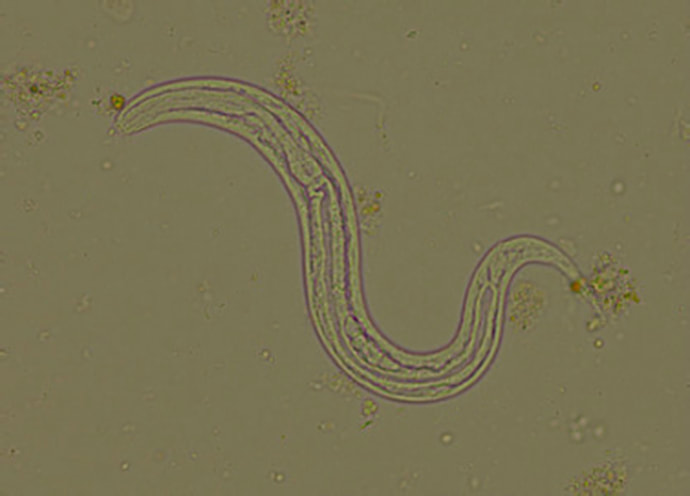Confiscated dogsThirteen Dachshund puppies ranging in age from approximately 6 to12 weeks were rescued from an unlicensed breeding facility in Virginia. The puppies, as well as the dogs used for breeding, had been housed outdoors in metal crates. All of the dogs were emaciated, infested with fleas and ticks, and heavily coated in mud and feces. The dogs were confiscated and taken to a nearby animal hospital, where they were physically examined to assess overall health. As part of the exam, direct fecal smears and fecal flotations were performed. The following organism (~300 um in length) was found in fecal smears from several of the dogs: AnswerThe size and distinct esophageal bulb allow identification of this organism as a rhabditiform Strongyloides sp. larva. The Baermann technique is a sensitive method to recover this parasite stage in feces, but larvae are also often found on direct smear. Strongyloides stercoralis can infect both dogs and humans. Infection is often associated with poor sanitation and crowding. Parasitic worms are female and reside embedded in the mucosa of the small intestine. Mature females reproduce by parthenogenesis and release eggs which often hatch within the intestine and rhabditiform larvae are passed in the feces of the definitive host. In the environment, the rhabditiform larvae undergo successive molts to become either filariform larvae or free-living adult males and females. Filariform larvae are infective to definitive hosts by ingestion or skin penetration, which may give rise to dermatitis. Larvae then enter the circulation and lymphatics and migrate to the small intestine via several pathways to become adult females. Strongyloides stercoralis infections are notoriously chronic due to autoinfection, which occurs when rhabditiform larvae develop to filariform larvae within the large intestine and penetrate the intestinal mucosa or perianal skin. Immunosuppression may allow the parasite to disseminate to other organs. Disseminated strongyloidiasis is often amplified by autoinfection, and is a life-threatening condition. (The photomicrograph used to illustrate this case was acquired from the Centers for Disease Control website.) |
Archives
July 2024
Have feedback on the cases or a special case you would like to share? Please email us ([email protected]). We will appropriately credit all submittors for any cases and photos provided.
|

